William J. O’Neil Idea List“RS Line Breaks To New Highs”!
- 2023-10-25
In the medical field, top-tier physicians utilize imaging technologies such as X-rays, MRI, and CT scans for accurate diagnosis, and any physician overlooking these essential diagnostic tools might be questioned on theirprofessionalism. Similarly, in finance, astute investors must adeptly read and interpret stock price charts, as they precisely reflect the dynamics of global capital markets., stock price charts not only represent the performance of stock prices but also indicate the supply-demand change in the financial markets. The “RS Line Breaks To New Highs” is one of the pivotal patterns on a stock chart. Investors who can proficiently utilize advanced analytical tools like the RS line and RS ratings to gauge stock price movements undoubtedly possess an advantageous position in the intricate financial markets.
Stock Selection Criteria
Within the analytical framework of Marketsmith, the performance of stock price charts offers investors a granular view of market dynamics, revealing the potential trajectory and investment value of stocks, while also providing robust support for asset allocation and risk management. Guided by continuous market monitoring, we adhere to the core principle: ifstock price decline to 8% below its purchase price, investment strategies should be reassessed andpositions should be reduced, thereby preserving capital for more enticing investment opportunities.
To more precisely determine the timing for buying and selling stocks, the new highs of the RS line (Relative Strength line) serve as a crucial technical analysis pattern, assisting investors in optimizing their portfolios and enhancing overall performance. Moreover, O’Neil’s unique evaluation method – the RS rating (Relative Strength of stock price) – offers investors further insights. Though these two methods differ in their calculation approach, they form an integral decision-making system in the investment process.
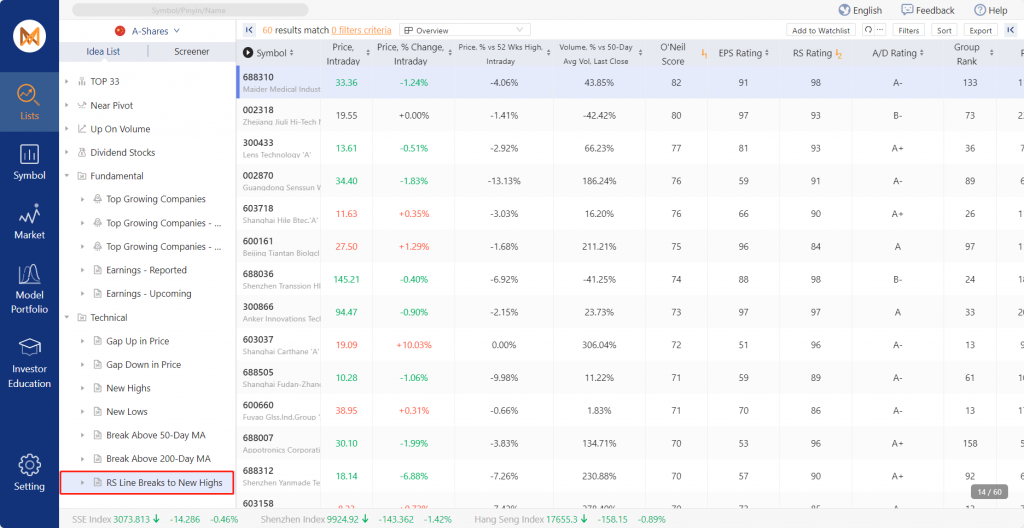
Relative Strength Line (RS线)
In contemporary investment strategies, the RS line, or “Relative Strength Line”, plays a pivotal role. It is also referred to as the Relative Strength Indicator. It’s not merely a simple technical indicator, but a detailed interpretation of the performance of an investment asset (such as a stock) in comparison to a specific benchmark index.
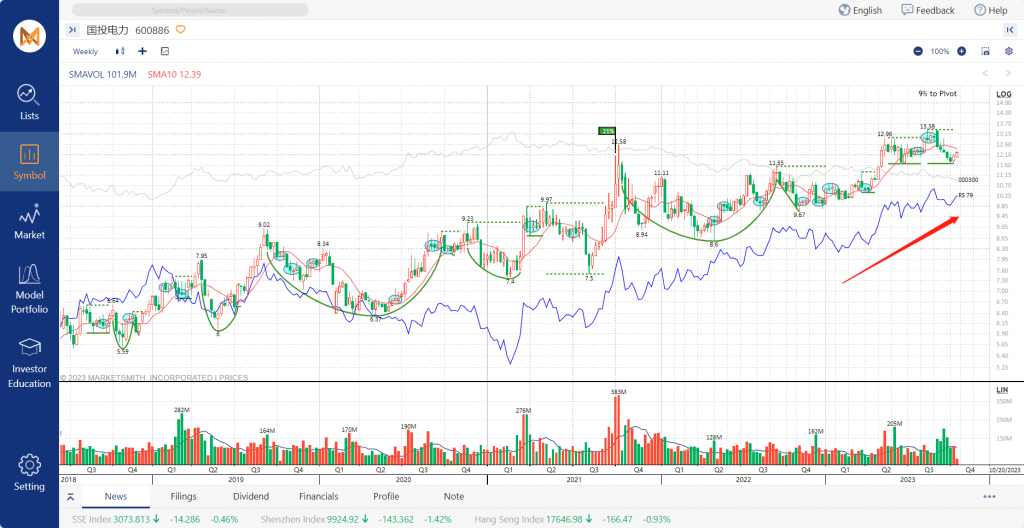
Construction of the RS Line
- Benchmark Determination: Firstly, from a macroeconomic perspective, choose a representative market index or a specific industry reference indicator, such as the Shanghai Stock Exchange Index or the CSI 300 Index, to serve as a reference benchmark. This step is crucial as it determines whether the RS line reflects relative strength against the overall market or a specific niche market.
- Relative Percentage Rise/Fall Calculation: Within the quantitative model, compare the price dynamics of the underlying asset with the benchmark index, further calculating its relative percentage rise or fall. This data provides a key input variable for subsequent strategies, especially in hedging strategies and asset allocation.
- RS Line Charting: Using the relative percentage rise or fall, the RS line is plotted, presenting a graphical representation of the relative strength and trend of the target, allowing investors to quickly capture market opportunities and risks, thus making more intelligent investment decisions.
In the complex financial market, the RS line provides a systematic, structured method to assess the relative value of an underlying asset and plays a central role in broader investment strategies, such as momentum strategies, long-short hedging strategies, etc.
In capital market analysis, the RS line (Relative Strength Line) holds core strategic value. It provides analysts and investors with a precise tool for measuring the performance disparity of a specific stock relative to the market benchmark.
When we see the RS line trending upwards, it may suggest that the stock, relative to its chosen benchmark, is generating excess returns, which could be interpreted as a investment opportunity or a buy signal. Conversely, a declining RS line might indicate the stock’s relative underperformance, potentially serving as a potential reduction or sell trigger point.
For professional investors, a meticulous analysis of the subtle changes in the RS line can reveal potential market anomalies, discern the relative momentum of assets, whether strengthening or weakening, further guiding their investment decisions. However, for a prudent investor, it’s essential to note that while the RS line offers strong support, it’s just one of O’Neil’s myriad analysis tools. For a more comprehensive and balanced market perspective, the RS line should be combined with other technical analysis tools and fundamental factors. These can be viewed on the relevant features page of Marketsmith.hk, ensuring a holistic interpretation of the market from multiple dimensions, building a comprehensive investment strategy framework.
RS Line Breaks To New Highs
In modern financial market analysis, the performance of the RS line is often viewed by portfolio managers and analysts as a pivotal indicator. Within the “Smart List – Technical Analysis” strategy framework provided by Marketsmith.hk, there’s a dedicated stock list focusing on the RS line, “RS Line Breaks To New Highs.” The purpose is to filter out stocks where, around key technical pattern breakouts, the RS line achieves historical highs. The specific filtering criteria are as follows:
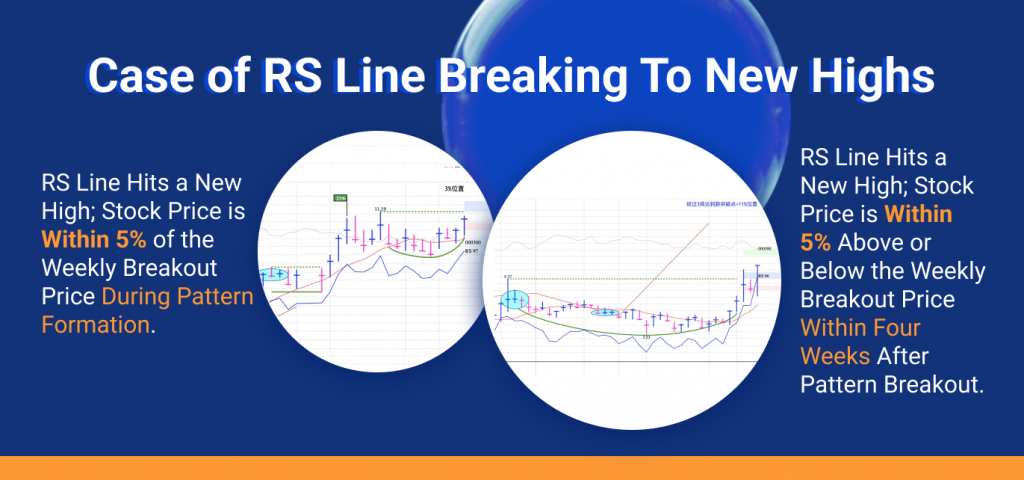
RS Line Hits a New High; Stock Price is Within 5% of the Weekly Breakout Price During Pattern Formation.
China Construction Bank (601939) as an example, as shown in the chart, we observe that the stock’s RS line has reached a new peak. Additionally, the stock price currently displays a typical cup pattern, with only a 2% deviation from the anticipated breakout point. This performance aligns with the filtering criteria for the “RS Line Breaks To New Highs”, clearly highlighting the stock’s potential as an investment candidate for superior returns. Thus, it’s worth investors’ consideration to add it to the “MS-Watchlist” for further analysis and monitoring.
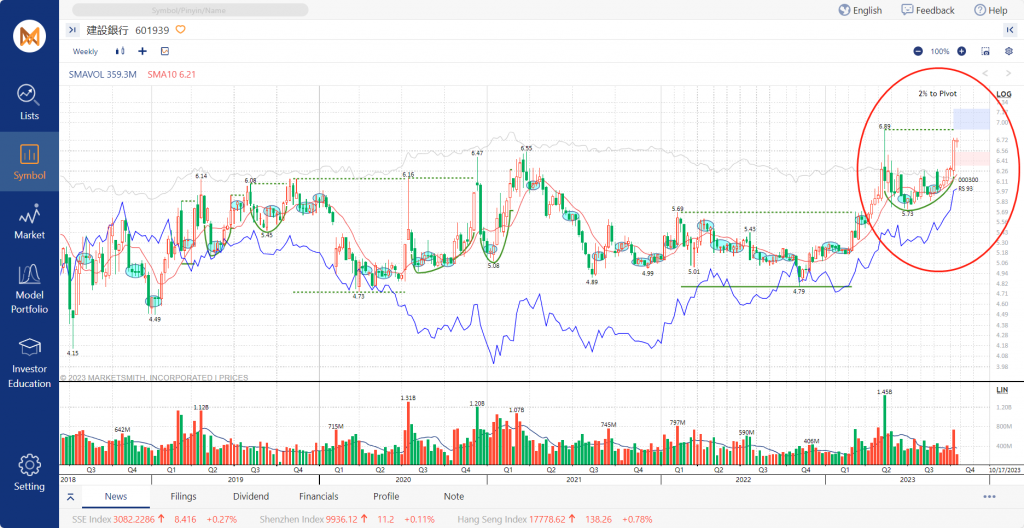
Or, RS Line Hits a New High; Stock Price is Within 5% Above or Below the Weekly Breakout Price Within Four Weeks After Pattern Breakout.
For instance the stock Xingyu Shares (601799),as depicted in the chart, we can observe that its RS line has already achieved a new peak. Two weeks after the breakout of its cup pattern, the stock price has reached -1% of the breakout price. Such a scenario aligns with our RS line strategy filtering criteria, further emphasizing its investment value within the asset portfolio.
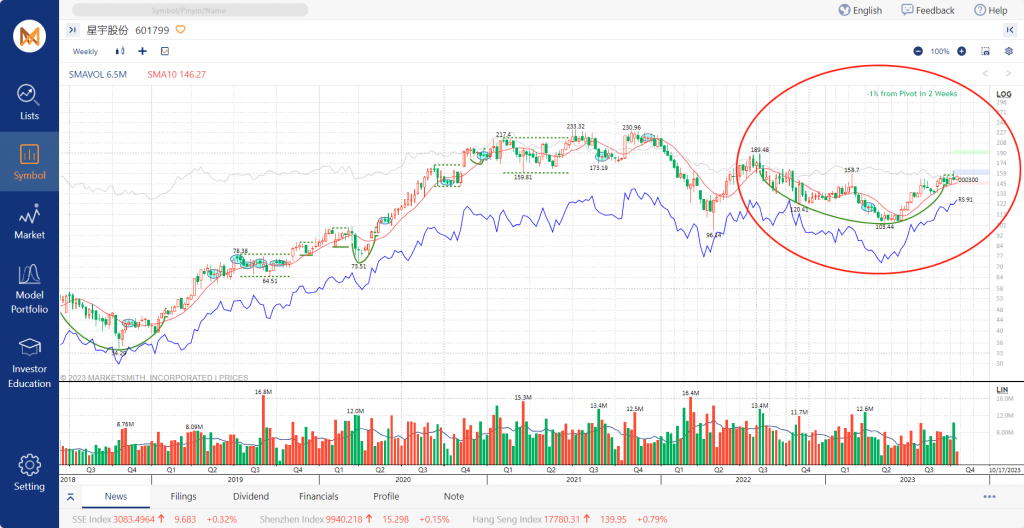
It’s essential to note that if the RS line displays a downward trend for seven consecutive months, or exhibits an unusually sharp decline over four consecutive months, this serves as a clear risk warning. It may foretell potential risks, and investors should consider adjusting their positions promptly, applying stringent risk control measures.
RS Rating System
In the in-depth research and strategy analysis of the capital markets, O’Neil’s unique RS Rating System (Relative Strength of stock price) is a widely recognized metric for quantitatively analyzing a stock’s performance relative to all other stocks in the market over the past 52 weeks. In the technical analysis charts of MS, the RS line provides two key data points: firstly, the RS Rating value (RS90), and secondly, the associated benchmark index (000300). Notably, these benchmark indices are selectable, allowing investors to adjust based on different market environments or strategic needs.
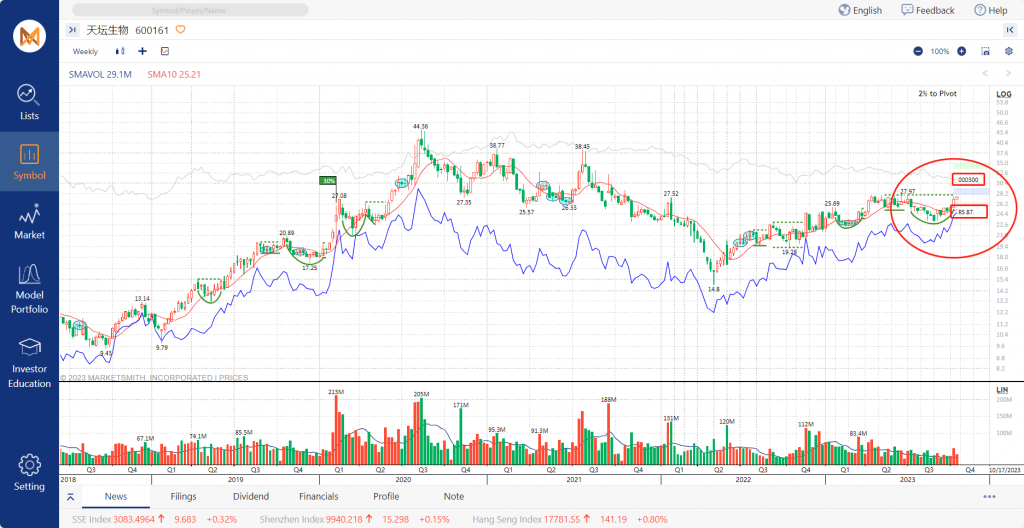
Within the RS Rating System, each stock is assigned a value between 1 and 99, with 99 representing the pinnacle of stocks relative market. An RS value of 99 implies that the stock’s price performance is better than 99% of the stocks in the market. Conversely, an RS value of 50 indicates that the stock outperforms 50% of stocks but underperforms 49% of the companies.
If the RS rating of an investment target is below 70, it might indicate that the stock currently exhibits weaker relative performance in the market. However, this doesn’t directly imply its future price trend. It merely points out that its momentum might be less than that of other stocks in the market.
Our research indicates that stocks with an RS rating average of 87 prior to massive upticks were already outperforming nearly 90% of other stocks even before their significant price surge. Hence, from an investment strategy perspective, high-net-worth and institutional investors tend to focus on stocks with higher RS ratings, avoiding those with RS ratings in the 40, 50, or 60 range. This metric can be swiftly viewed in the “MS-Individual Stock Evaluation”.
Conclusion
In thecomplex capital markets, relying solely on intuition and preliminary analysis of stocks is insufficient. Even when certain stocks begin to show potential profitability, investors must employ a variety of analytical tools and technical indicators to delve deep into potential investment opportunities, ensuring every decision is based on precise comprehensive data assessment.
At Marketsmith.hk, what we offer is not just data but a validated, structured stock-picking strategy aimed at pinpointing leading stocks that truly have the potential for outsized returns. Especially those that demonstrate: positive momentum in the RS line, breakthrough price patterns, and RS ratings above 80 or 90 should receive particular attention. These factors are often common traits of quality stocks. However, strategic risk management is equally indispensable. Always bear in mind that if a stock’s price falls below 8% of its purchase price, it should be reassessed, considering reducing or liquidating the position to protect capital from unnecessary losses.